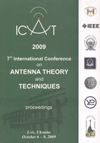Possible way to increasing of finite-difference time-domain algorithm efficiency
DOI:
https://doi.org/10.1109/ICATT.2009.4435181Keywords:
finite-difference time-domain method, fast Fourier transformation, scattering diagramAbstract
When we use pulsed input signal for finite-difference time-domain method (FDTD) there are the actual problem of computing resources reduction. Possible means to solve this problem are analyzed. Using of Fast Fourier Transformation (FFT) with increased time sampling step has been considered. It is shown that there is a certain optimum value of this parameter. Scattering diagram (SD) calculation results divergence for pulsed and monochromatic input signals has been researched at broad frequency band. These results difference reasons for lower and higher frequencies are explained. Attention has been paid to the fact that number of FFT time discrete step must to correspond to definite rule. It is shown how influences upon computing algorithm stability detour from this rule. Relationships between pulsed input signal duration and SD calculation accuracy for different time sampling steps has been considered.References
MUR, G. Absorbing boundary conditions for the finite-difference approximation of the time-domain electromagnetic-field equations. IEEE Trans. Electr. Compat., 1981, v.EMC-23, n.4, p.377-382.
MEREWETHER, D.E.; FISHER, R.; SMITH, F.W. On implementing a numeric Huygen’s source scheme in a finite difference program to illuminate scattering bodies. IEEE Trans. Nucl. Scien., 1980, v.NS-27, n.6, p.1819-1833.
BASKAKOV, S.I. Radiotelephony Circuits and Signals: Textbook. Moscow: High School, 2003.
BRONSHTEIN, I.N.; SEMENDYAEV, K.A. Guide to Mathematics for Engineers and High School Students. Moscow: Science, 1981, 149 p.
Published
2009-10-10
Issue
Section
Analytical and numerical techniques

